Business Decision Making Assignment: NPV, IRR, Sampling Methods
VerifiedAdded on 2023/01/06
|10
|1095
|93
Homework Assignment
AI Summary
This document presents a comprehensive solution to a business decision-making assignment. It begins with an analysis of a project using Net Present Value (NPV), advising against investment based on a negative NPV and considering other factors like time horizon and risk. The assignment then delves into sampling methods, including simple random, systematic, clustered, stratified, and convenience sampling, along with their respective advantages and disadvantages. Key concepts like population, sample, and sampling frame are clearly explained. Finally, the solution explores mathematical tools for capital appraisal, focusing on the payback period and Internal Rate of Return (IRR), with detailed calculations for two projects, demonstrating how to determine the most financially viable option. The document is designed to aid students in understanding and applying crucial business decision-making techniques.

Business Decision Making
Paraphrase This Document
Need a fresh take? Get an instant paraphrase of this document with our AI Paraphraser

Contents
MAIN BODY..............................................................................................................................................3
Section A.................................................................................................................................................3
Section B.................................................................................................................................................5
MAIN BODY..............................................................................................................................................3
Section A.................................................................................................................................................3
Section B.................................................................................................................................................5
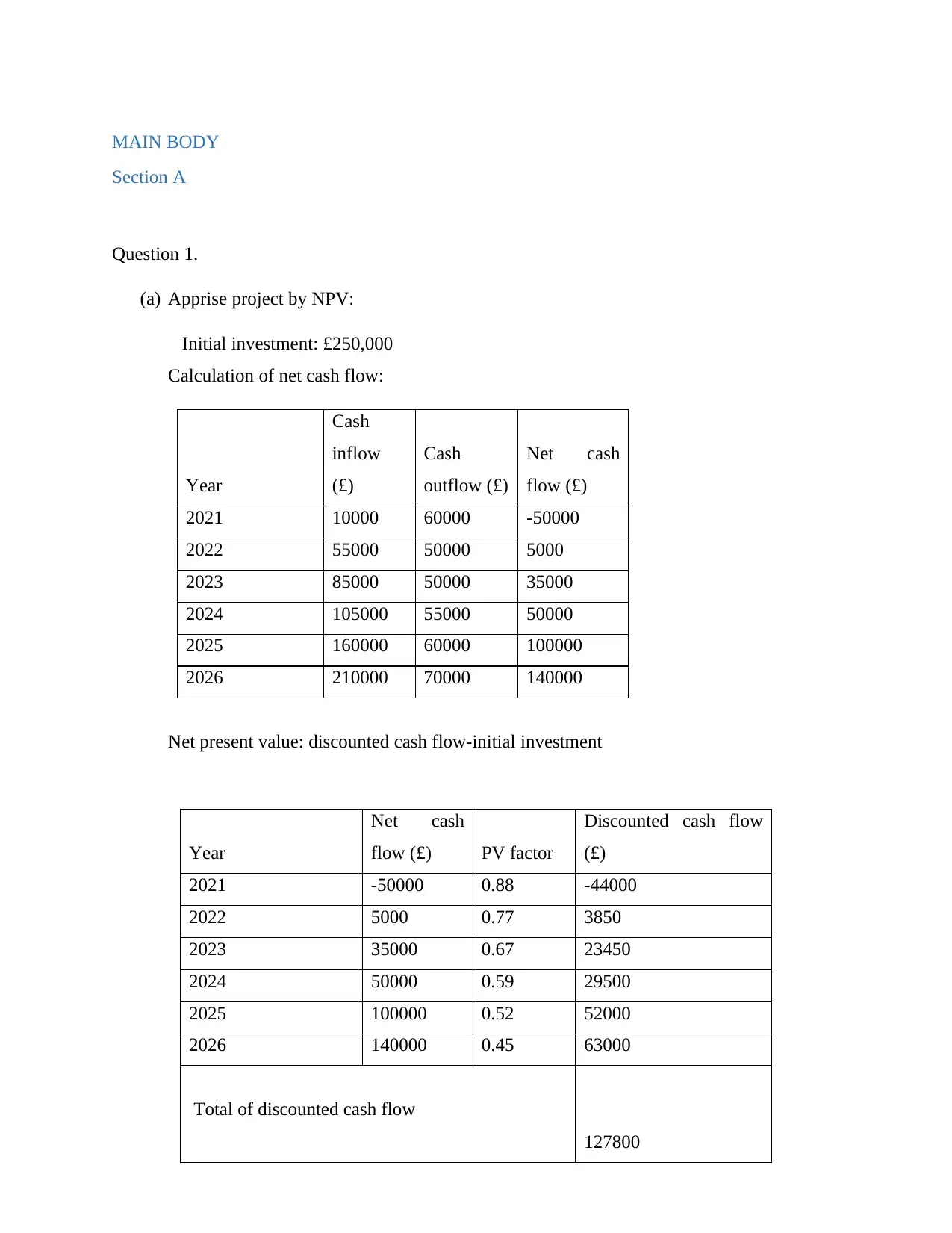
MAIN BODY
Section A
Question 1.
(a) Apprise project by NPV:
Initial investment: £250,000
Calculation of net cash flow:
Year
Cash
inflow
(£)
Cash
outflow (£)
Net cash
flow (£)
2021 10000 60000 -50000
2022 55000 50000 5000
2023 85000 50000 35000
2024 105000 55000 50000
2025 160000 60000 100000
2026 210000 70000 140000
Net present value: discounted cash flow-initial investment
Year
Net cash
flow (£) PV factor
Discounted cash flow
(£)
2021 -50000 0.88 -44000
2022 5000 0.77 3850
2023 35000 0.67 23450
2024 50000 0.59 29500
2025 100000 0.52 52000
2026 140000 0.45 63000
Total of discounted cash flow
127800
Section A
Question 1.
(a) Apprise project by NPV:
Initial investment: £250,000
Calculation of net cash flow:
Year
Cash
inflow
(£)
Cash
outflow (£)
Net cash
flow (£)
2021 10000 60000 -50000
2022 55000 50000 5000
2023 85000 50000 35000
2024 105000 55000 50000
2025 160000 60000 100000
2026 210000 70000 140000
Net present value: discounted cash flow-initial investment
Year
Net cash
flow (£) PV factor
Discounted cash flow
(£)
2021 -50000 0.88 -44000
2022 5000 0.77 3850
2023 35000 0.67 23450
2024 50000 0.59 29500
2025 100000 0.52 52000
2026 140000 0.45 63000
Total of discounted cash flow
127800
⊘ This is a preview!⊘
Do you want full access?
Subscribe today to unlock all pages.

Trusted by 1+ million students worldwide
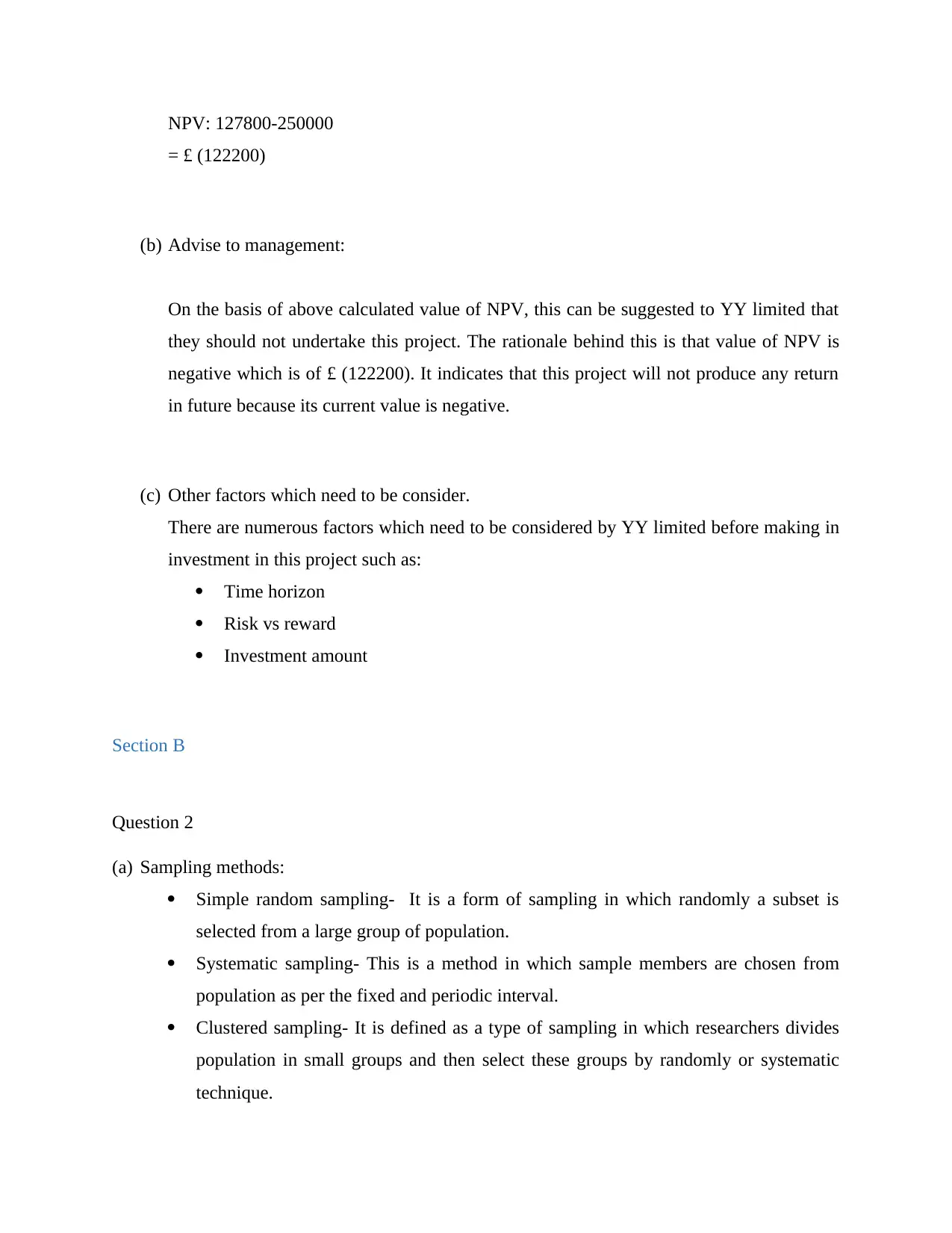
NPV: 127800-250000
= £ (122200)
(b) Advise to management:
On the basis of above calculated value of NPV, this can be suggested to YY limited that
they should not undertake this project. The rationale behind this is that value of NPV is
negative which is of £ (122200). It indicates that this project will not produce any return
in future because its current value is negative.
(c) Other factors which need to be consider.
There are numerous factors which need to be considered by YY limited before making in
investment in this project such as:
Time horizon
Risk vs reward
Investment amount
Section B
Question 2
(a) Sampling methods:
Simple random sampling- It is a form of sampling in which randomly a subset is
selected from a large group of population.
Systematic sampling- This is a method in which sample members are chosen from
population as per the fixed and periodic interval.
Clustered sampling- It is defined as a type of sampling in which researchers divides
population in small groups and then select these groups by randomly or systematic
technique.
= £ (122200)
(b) Advise to management:
On the basis of above calculated value of NPV, this can be suggested to YY limited that
they should not undertake this project. The rationale behind this is that value of NPV is
negative which is of £ (122200). It indicates that this project will not produce any return
in future because its current value is negative.
(c) Other factors which need to be consider.
There are numerous factors which need to be considered by YY limited before making in
investment in this project such as:
Time horizon
Risk vs reward
Investment amount
Section B
Question 2
(a) Sampling methods:
Simple random sampling- It is a form of sampling in which randomly a subset is
selected from a large group of population.
Systematic sampling- This is a method in which sample members are chosen from
population as per the fixed and periodic interval.
Clustered sampling- It is defined as a type of sampling in which researchers divides
population in small groups and then select these groups by randomly or systematic
technique.
Paraphrase This Document
Need a fresh take? Get an instant paraphrase of this document with our AI Paraphraser
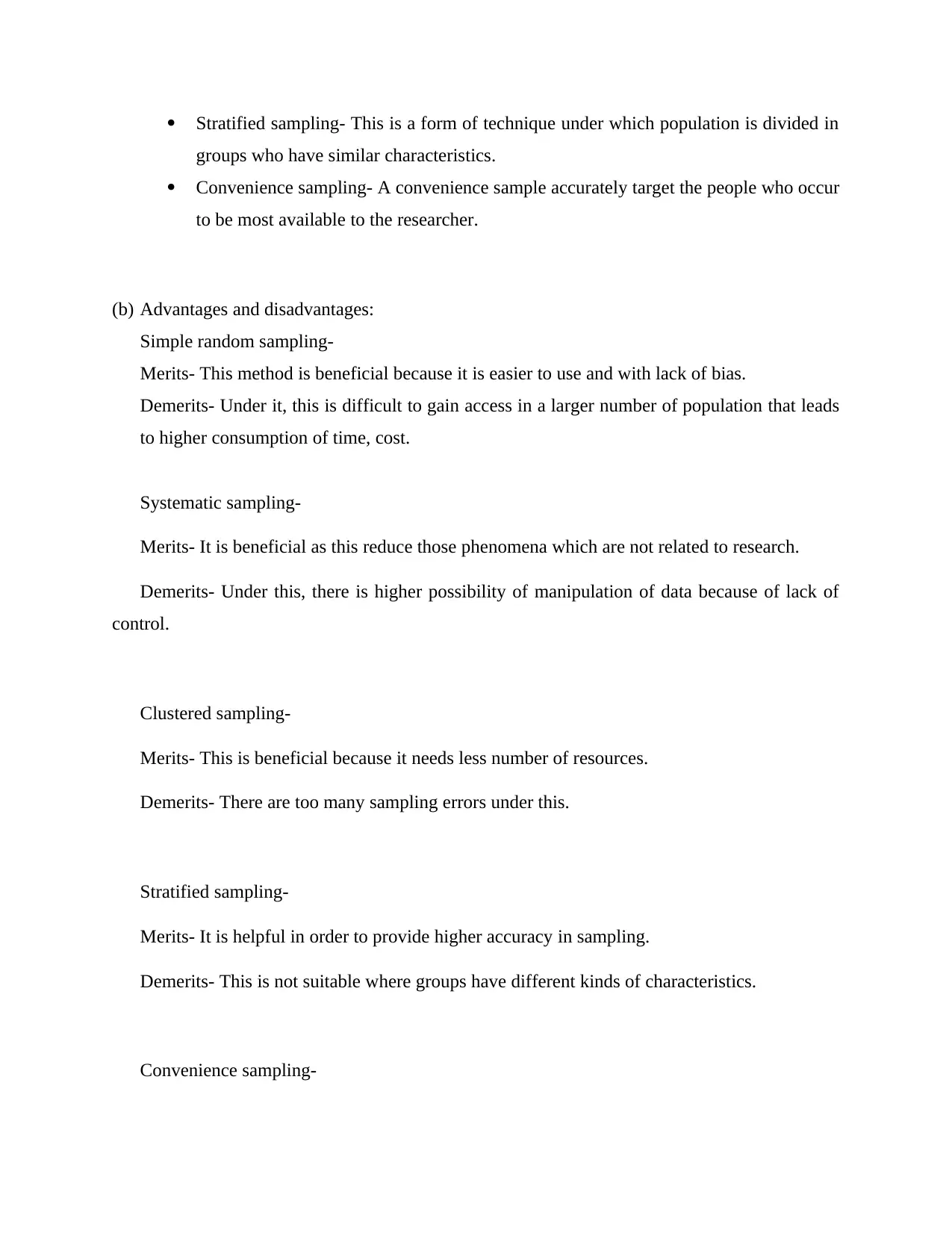
Stratified sampling- This is a form of technique under which population is divided in
groups who have similar characteristics.
Convenience sampling- A convenience sample accurately target the people who occur
to be most available to the researcher.
(b) Advantages and disadvantages:
Simple random sampling-
Merits- This method is beneficial because it is easier to use and with lack of bias.
Demerits- Under it, this is difficult to gain access in a larger number of population that leads
to higher consumption of time, cost.
Systematic sampling-
Merits- It is beneficial as this reduce those phenomena which are not related to research.
Demerits- Under this, there is higher possibility of manipulation of data because of lack of
control.
Clustered sampling-
Merits- This is beneficial because it needs less number of resources.
Demerits- There are too many sampling errors under this.
Stratified sampling-
Merits- It is helpful in order to provide higher accuracy in sampling.
Demerits- This is not suitable where groups have different kinds of characteristics.
Convenience sampling-
groups who have similar characteristics.
Convenience sampling- A convenience sample accurately target the people who occur
to be most available to the researcher.
(b) Advantages and disadvantages:
Simple random sampling-
Merits- This method is beneficial because it is easier to use and with lack of bias.
Demerits- Under it, this is difficult to gain access in a larger number of population that leads
to higher consumption of time, cost.
Systematic sampling-
Merits- It is beneficial as this reduce those phenomena which are not related to research.
Demerits- Under this, there is higher possibility of manipulation of data because of lack of
control.
Clustered sampling-
Merits- This is beneficial because it needs less number of resources.
Demerits- There are too many sampling errors under this.
Stratified sampling-
Merits- It is helpful in order to provide higher accuracy in sampling.
Demerits- This is not suitable where groups have different kinds of characteristics.
Convenience sampling-

Merits- This plays a key role in the context of large number of data.
Demerits- There is huge possibility of under and over representation of data.
(c) Explanation of sample, sampling and sampling frame.
Population: It is defined to comprehensive group of people, objects along with institutions
which have common characteristics which are interest of researcher.
Sample: It is termed to set of people selected or collected from statistical population by
identified procedure. In other words, sample is small part of quantity that intends to show
what entire is like.
Sample frame: It is source material from which sample is taken or drawn. It is list of entire
things within population that can be sampled or includes individuals, institutions and so on.
Question 5.
(i) Types of mathematical tools for capital appraisal decisions.
Payback period- It is form of method in which estimated time period is
computed which may occur to cover invested amount.
NPV- This method computes current value of project by eliminating initial
investment from discounted cash flows.
(ii) Payback period: Year before recovery+ amount to be recover/next years’ cash flow
Project A
Investment: £50000
Calculation of net cash flow:
year Cash inflow cash outflow net cash flow
Demerits- There is huge possibility of under and over representation of data.
(c) Explanation of sample, sampling and sampling frame.
Population: It is defined to comprehensive group of people, objects along with institutions
which have common characteristics which are interest of researcher.
Sample: It is termed to set of people selected or collected from statistical population by
identified procedure. In other words, sample is small part of quantity that intends to show
what entire is like.
Sample frame: It is source material from which sample is taken or drawn. It is list of entire
things within population that can be sampled or includes individuals, institutions and so on.
Question 5.
(i) Types of mathematical tools for capital appraisal decisions.
Payback period- It is form of method in which estimated time period is
computed which may occur to cover invested amount.
NPV- This method computes current value of project by eliminating initial
investment from discounted cash flows.
(ii) Payback period: Year before recovery+ amount to be recover/next years’ cash flow
Project A
Investment: £50000
Calculation of net cash flow:
year Cash inflow cash outflow net cash flow
⊘ This is a preview!⊘
Do you want full access?
Subscribe today to unlock all pages.

Trusted by 1+ million students worldwide
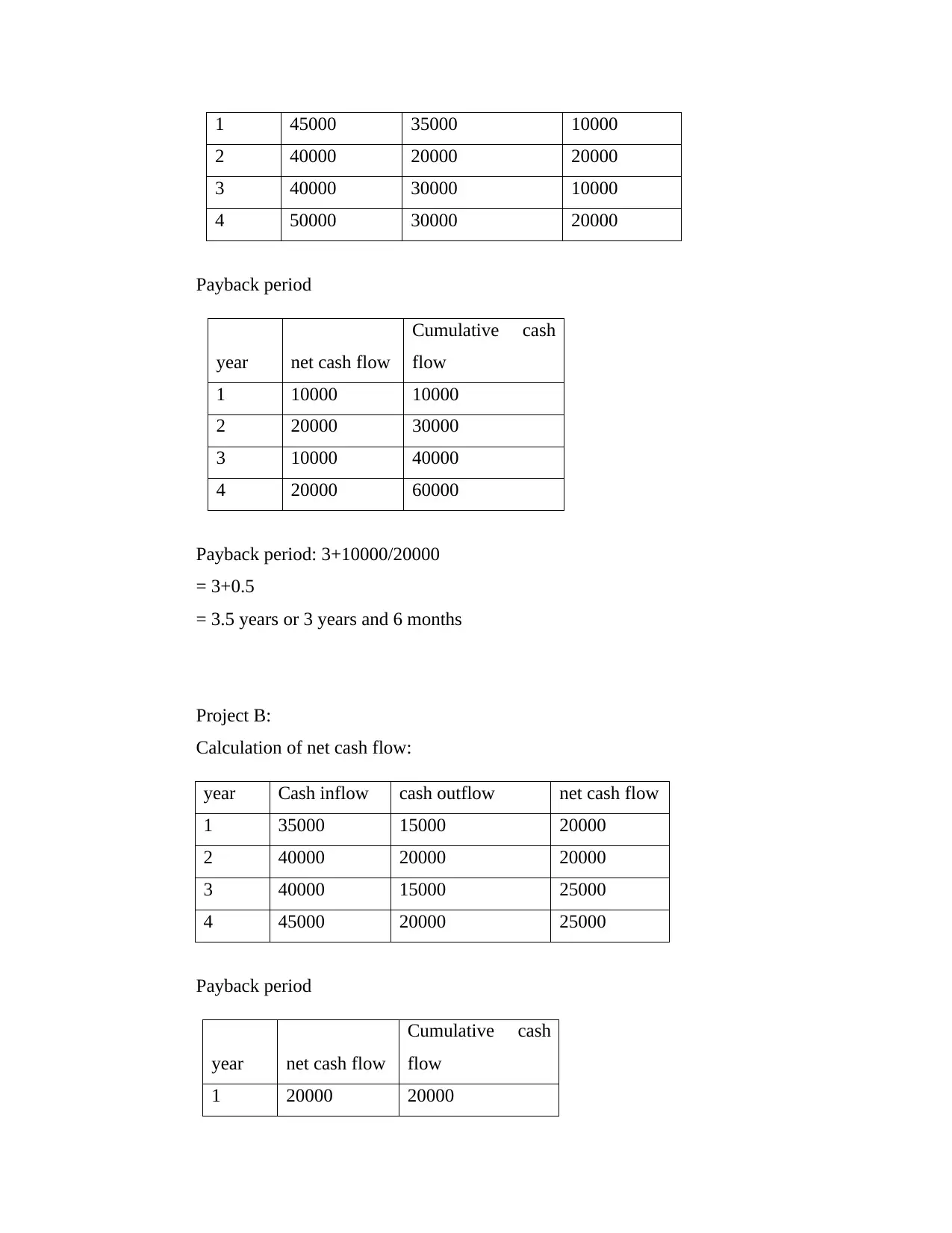
1 45000 35000 10000
2 40000 20000 20000
3 40000 30000 10000
4 50000 30000 20000
Payback period
year net cash flow
Cumulative cash
flow
1 10000 10000
2 20000 30000
3 10000 40000
4 20000 60000
Payback period: 3+10000/20000
= 3+0.5
= 3.5 years or 3 years and 6 months
Project B:
Calculation of net cash flow:
year Cash inflow cash outflow net cash flow
1 35000 15000 20000
2 40000 20000 20000
3 40000 15000 25000
4 45000 20000 25000
Payback period
year net cash flow
Cumulative cash
flow
1 20000 20000
2 40000 20000 20000
3 40000 30000 10000
4 50000 30000 20000
Payback period
year net cash flow
Cumulative cash
flow
1 10000 10000
2 20000 30000
3 10000 40000
4 20000 60000
Payback period: 3+10000/20000
= 3+0.5
= 3.5 years or 3 years and 6 months
Project B:
Calculation of net cash flow:
year Cash inflow cash outflow net cash flow
1 35000 15000 20000
2 40000 20000 20000
3 40000 15000 25000
4 45000 20000 25000
Payback period
year net cash flow
Cumulative cash
flow
1 20000 20000
Paraphrase This Document
Need a fresh take? Get an instant paraphrase of this document with our AI Paraphraser

2 20000 40000
3 25000 65000
4 25000 90000
Payback period: 2+10000/25000
= 2.04 years or 2 years and 4 months.
(iii) Internal rate of return:
Project A:
Lower discount rate: 5%
Higher discount rate: 10%
NPV at r a
NPV at r a: 52700-50000
year net cash flow PV
factor DCF
1 10000 0.95 9500
2 20000 0.91 18200
3 10000 0.86 8600
4 20000 0.82 16400
Discounted cash flow
52700
3 25000 65000
4 25000 90000
Payback period: 2+10000/25000
= 2.04 years or 2 years and 4 months.
(iii) Internal rate of return:
Project A:
Lower discount rate: 5%
Higher discount rate: 10%
NPV at r a
NPV at r a: 52700-50000
year net cash flow PV
factor DCF
1 10000 0.95 9500
2 20000 0.91 18200
3 10000 0.86 8600
4 20000 0.82 16400
Discounted cash flow
52700

= 2700 pounds
NPV at r b
year net cash flow PV
factor DCF
1 10000 0.91 9100
2 20000 0.83 16600
3 10000 0.75 7500
4 20000 0.68 13600
Discounted cash flow
46800
NPV at r b: 46800-50000
= -3200
IRR: 5+2700/[(2700-(3200)]*(10-5)
= 5+ 2700/-5900*5
= 5+ (2.28)
= 2.72%
Project B:
NPV at r a
year net cash
flow
PV
factor DCF
1 20000 0.95 19000
NPV at r b
year net cash flow PV
factor DCF
1 10000 0.91 9100
2 20000 0.83 16600
3 10000 0.75 7500
4 20000 0.68 13600
Discounted cash flow
46800
NPV at r b: 46800-50000
= -3200
IRR: 5+2700/[(2700-(3200)]*(10-5)
= 5+ 2700/-5900*5
= 5+ (2.28)
= 2.72%
Project B:
NPV at r a
year net cash
flow
PV
factor DCF
1 20000 0.95 19000
⊘ This is a preview!⊘
Do you want full access?
Subscribe today to unlock all pages.

Trusted by 1+ million students worldwide
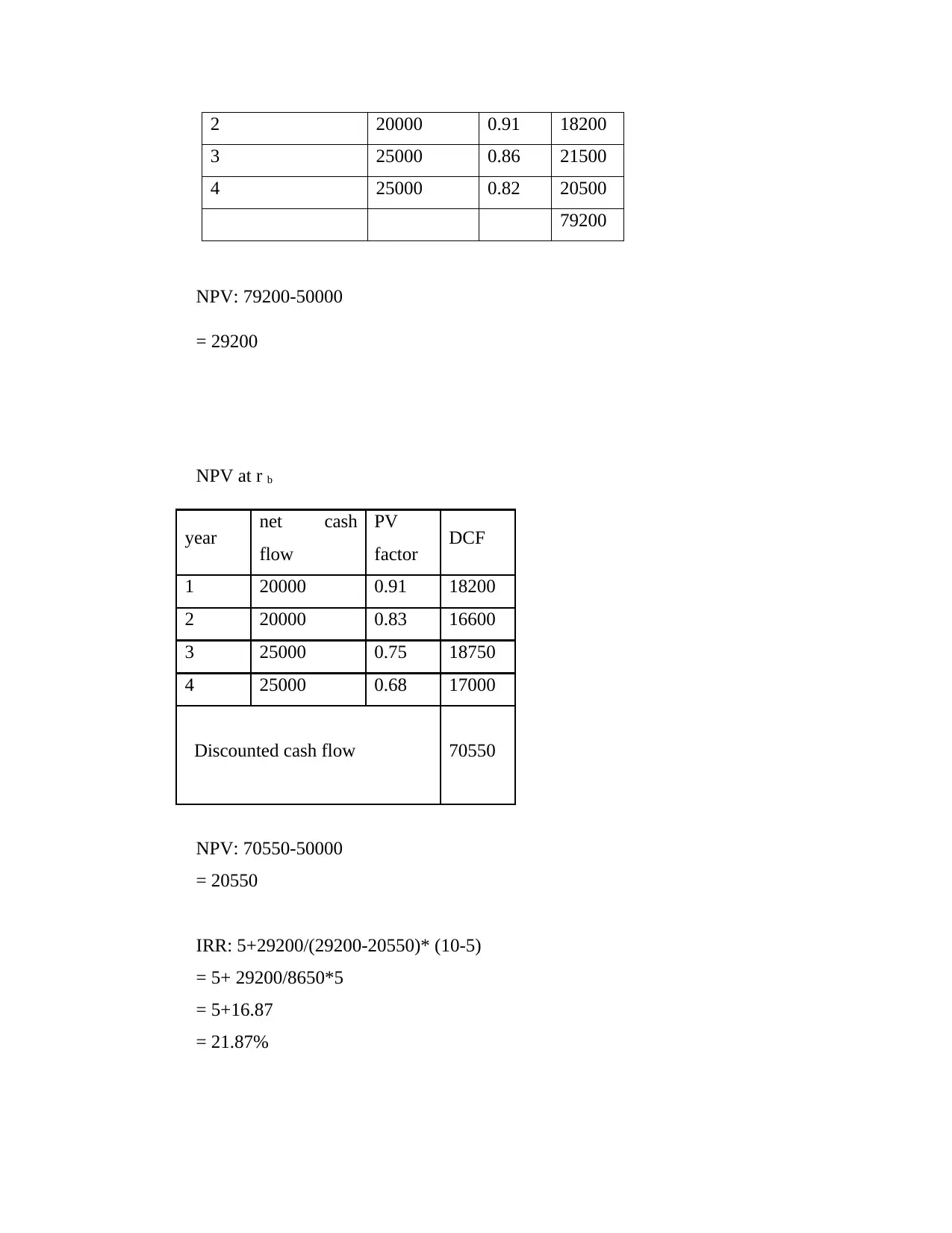
2 20000 0.91 18200
3 25000 0.86 21500
4 25000 0.82 20500
79200
NPV: 79200-50000
= 29200
NPV at r b
year net cash
flow
PV
factor DCF
1 20000 0.91 18200
2 20000 0.83 16600
3 25000 0.75 18750
4 25000 0.68 17000
70550Discounted cash flow
NPV: 70550-50000
= 20550
IRR: 5+29200/(29200-20550)* (10-5)
= 5+ 29200/8650*5
= 5+16.87
= 21.87%
3 25000 0.86 21500
4 25000 0.82 20500
79200
NPV: 79200-50000
= 29200
NPV at r b
year net cash
flow
PV
factor DCF
1 20000 0.91 18200
2 20000 0.83 16600
3 25000 0.75 18750
4 25000 0.68 17000
70550Discounted cash flow
NPV: 70550-50000
= 20550
IRR: 5+29200/(29200-20550)* (10-5)
= 5+ 29200/8650*5
= 5+16.87
= 21.87%
1 out of 10
Your All-in-One AI-Powered Toolkit for Academic Success.
+13062052269
info@desklib.com
Available 24*7 on WhatsApp / Email
![[object Object]](/_next/static/media/star-bottom.7253800d.svg)
Unlock your academic potential
Copyright © 2020–2025 A2Z Services. All Rights Reserved. Developed and managed by ZUCOL.
